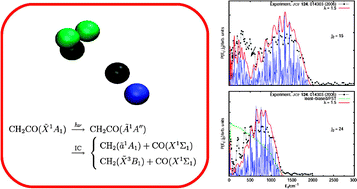An alternative methodology to investigate indirect polyatomic processes with quasi-classical trajectories is proposed, which effectively avoids any binning or weighting procedure while provides rovibrational resolution. Initial classical states are started in terms of angle-action variables to closely match the quantum experimental conditions and later transformed into Cartesian coordinates, following an algorithm very recently published [J. Chem. Phys. 2009, 130, 114103]. Trajectories are then propagated using the ‘association’ picture, i.e. an inverse dynamics simulation in the spirit of the exit-channel corrected phase space theory of Hamilton and Brumer [J. Chem. Phys. 1985, 82, 595], which is shown to be particularly convenient. Finally, an approximate quasi-classical formula is provided which under general conditions can be used to add possible rotational structures into the vibrationally-resolved quasi-classical distributions. To introduce the method and illustrate its capabilities, correlated translational energy distributions from recent experiments in the photo-dissociation of ketene at 308 nm [J. Chem. Phys. 2006, 124, 014303] are investigated. Quite generally, the overall theoretical algorithm reduces the total number of trajectories to integrate and allows for fully theoretical predictions of experiments on polyatomics.

You have access to this article
 Please wait while we load your content...
Something went wrong. Try again?
Please wait while we load your content...
Something went wrong. Try again?


 Please wait while we load your content...
Please wait while we load your content...